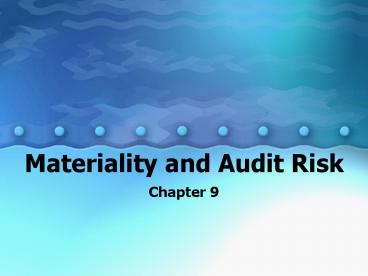Materiality and Audit Risk - PowerPoint PPT Presentation
1 / 13
Title:
Materiality and Audit Risk
Description:
Must be made to determine what is a material misstatement ... is a function of inherent risk, unchecked by controls and not detected by the auditor ... – PowerPoint PPT presentation
Number of Views:728
Avg rating:3.0/5.0
Title: Materiality and Audit Risk
1
Materiality and Audit Risk
- Chapter 9
2
Materiality
- The definition is the same in the auditing
context as everywhere else in accounting - Key references
- Reasonable assurance
- Free of material misstatement
3
Preliminary Judgment
- Must be made to determine what is a material
misstatement - Often based on initial financial statements
- Qualitative factors as well
- Fraud
- Changes in trends
- Remember it is all relative
- Must always be subject to revision
4
Allocation of Materiality
- The auditor looks for amounts that are material
in the aggregate - More commonly allocated to balance sheet
accounts, then by extension to income statement - Tolerable misstatement Material amount for any
given account - May be adjusted for fraud and for cost of audit
procedures - Sampling formulae depend on tolerable misstatement
5
Estimating Misstatement
- Discovered error is projected onto the total
- Example inventory in sample is overstated by 3,
then total is assumed to be by 3 - More specific confidence intervals depend on
statistical parameters - Total is compared to tolerable amount
- If it exceeds, may increase testing or demand
adjustment
6
Audit Risk Model
- AR IR x CR x DR
- AR Audit risk
- The risk that the auditor will incorrectly issue
an unqualified opinion - IR Inherent risk
- The risk of material misstatements absent any
internal controls or testing
7
Audit Risk Model
- CR Control risk
- The risk that internal controls will fail to
prevent or detect material misstatement - DR Detection risk
- The risk that audit tests will fail to detect
material mistatement - Therefore, audit risk is a function of inherent
risk, unchecked by controls and not detected by
the auditor
8
Risk Components
- Inherent risk
- Higher in complex transactions
- Higher where items are more naturally prone to
fraud - Based in part on prior experience
- Industry and management pressures
- Inherent risk cannot be changed by the auditor
it just is - Control risk
- Depends on the design and execution of controls
- Where controls are good, risk is low
9
Risk Components, II
- More Control risk
- Depends on all 5 COSO categories
- Observed by the auditor but cannot be changed
retroactively - Detection risk
- A function of the types of tests the auditor does
- Remember nature, timing, and extent
- This is the only risk element that can be
controlled by the auditor - AR IR x CR x DR also means
- DR AR / (IR x CR)
10
Is Risk Quantifiable?
- Yes and No
- Often assessed in percentage terms
- Requires judgment because no number is out there
to be measured - Detection risk needs to be quantified for
statistical testing
11
Interrelationship of Risks
- IF IR and CR are high, then
- If IR is high and CR is low
- If IR is low and CR is low
- If IR is low but CR is high
- DR should be low (lots of testing)
- DR can be higher, because controls offset high IR
- DR can be high
- Somewhat indicative of fraud. DR should be very
low
12
What is Acceptable Audit Risk?
- Risk the auditor is willing to take of being
wrong - Generally considered in terms of unqualified
where there are misstatements, but not in reverse - Depends on engagement risk
- Financial stability
- Industry factors
- Management integrity
- Degree of reliance on audited statements
13
Keep Things Open
- Materiality judgments are subject to revision
- If original bases were overstated, threshold may
be too high - Control risk assessment must be backed up by
control testing results - If tests show weaker controls, CR is higher, thus
DR needs to be lower































